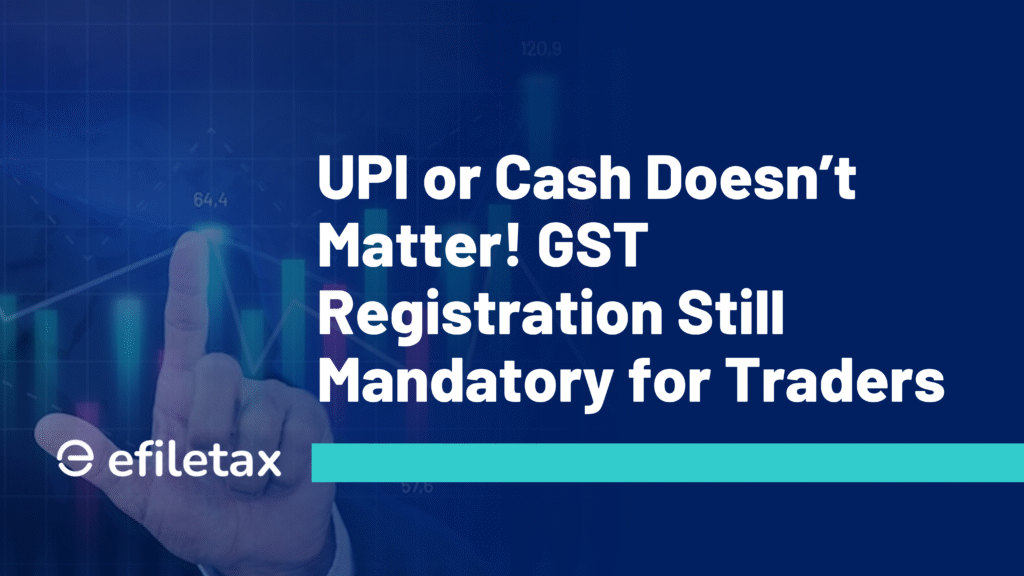
GST Registration Rules for Digital Payments: What Karnataka Clarified
On 11th July 2025, Karnataka’s GST Department issued a much-needed clarification on GST registration rules for traders using digital payment modes like UPI, card, or wallets. This comes after several media reports triggered panic among small traders, suggesting that even accepting UPI might force GST registration.
Let’s simplify what the law actually says — and what it doesn’t.
Key Clarification: GST Registration Is Turnover-Based, Not Payment-Based
Here’s what the Karnataka GST Department clarified:
- GST registration is mandatory if:
- Turnover exceeds ₹40 lakh/year for goods
- Or ₹20 lakh/year for services
- This holds regardless of the payment mode: UPI, QR code, bank transfer, credit/debit card, Paytm, PhonePe, BharatPe, or even cash
✅ So, using digital payment gateways does not automatically trigger GST registration.
❌ But crossing the turnover limit does, even if all sales are in cash.
Composition Scheme Still Available
Small traders need not worry about complicated filings. The Composition Scheme is available if:
- Annual turnover is below ₹1.5 crore
- Trader deals only in goods (not services except restaurant)
- Taxes can be paid at just 1% (0.5% CGST + 0.5% SGST)
📌 As of July 2025, 98,915 traders in Karnataka are already using this simplified scheme.
Why the Panic Happened
Recent notices from the GST department and viral posts created confusion by implying:
- GST registration is needed just for using UPI
- Accepting digital payments brings you under GST net
But this is not correct, unless turnover crosses limits.
Aadhaar + Biometric for New Registrations
To reduce fake registrations and improve taxpayer verification, the GSTN (Goods and Services Tax Network) now requires:
- Aadhaar authentication
- Biometric verification (photo + fingerprint)
This has made the registration process more robust — not more difficult.
Practical Tip from Experts
“Digital transactions may leave a trace, but GST liability is always tied to turnover — not how you receive money. Traders should track their aggregate annual turnover, not just fear tech tools like UPI.”
— Tax Consultant associated with Efiletax
Compliance Insight
If you’re a small business:
- ✅ You can accept UPI, Google Pay, or card payments without worry
- ✅ But you must register for GST once you cross turnover threshold
- ✅ Consider voluntary registration if you’re near the limit — it helps with input tax credit (ITC)
- ✅ If eligible, opt for Composition Scheme to reduce compliance burden
Legal Reference
- Section 22 of the CGST Act, 2017: Mandatory registration on turnover basis
- Rule 8 and Rule 9 of CGST Rules: Aadhaar authentication & biometric norms
- Karnataka State GST Circular dated 11.07.2025 (source: gst.kar.nic.in)
Summary
Karnataka GST clarified that GST registration is mandatory based on turnover, not digital payment mode. UPI or cash – same rule applies. Traders below ₹40L (goods) or ₹20L (services) are exempt, but must register if they cross the limit. Composition Scheme still available.
FAQs
Q1: I sell goods worth ₹30 lakhs annually via UPI. Do I need GST registration?
A: No, as long as turnover is below ₹40 lakh, GST registration is not mandatory.
Q2: If I receive cash only, do I still need GST registration?
A: Yes, if turnover exceeds ₹40 lakh (goods) or ₹20 lakh (services).
Q3: Is accepting UPI on QR code a reason to get GST registered?
A: No, registration depends on turnover, not mode of receipt.
Q4: What if I run a shop and cross ₹1.5 crore turnover?
A: You’re no longer eligible for Composition Scheme and must follow regular GST rules.
Final Take
Digital payments are not a trap. They bring transparency, yes — but GST law stays focused on turnover. If you’re a small trader using UPI and under the threshold, you’re still out of the GST net.
But if you’re growing fast — register early, choose the right scheme, and stay compliant.